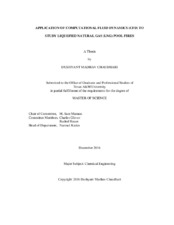| dc.contributor.advisor | Mannan, M. Sam | |
| dc.creator | Chaudhari, Dushyant Madhav | |
| dc.date.accessioned | 2017-03-02T16:47:55Z | |
| dc.date.available | 2018-12-01T07:20:15Z | |
| dc.date.created | 2016-12 | |
| dc.date.issued | 2016-12-07 | |
| dc.date.submitted | December 2016 | |
| dc.identifier.uri | https://hdl.handle.net/1969.1/159022 | |
| dc.description.abstract | Liquefied Natural Gas (LNG) pool fires pose a major risk to LNG facilities. The radiant energy from a LNG pool fire can be sufficiently high to threaten the structural integrity of the facility, plant personnel, fire fighters and potentially people beyond the boundaries of the facility. Safety analysis for LNG consequence modeling requires protection of the public against hazards caused by LNG pool fires. Current safety analysis involves the use of empirical models to assess the effects of a pool fire. Application of these models to pool fires of different size pose significant uncertainty in terms of underestimation of key parameters.
In this study, a CFD (Computational Fluid Dynamic) software is used to advance the knowledge of LNG pool fire modeling. The Fire Dynamic Simulator (FDS) code is used to simulate pool fire of a small scale experiment to study the sensitivity of different pool fire characteristics on turbulence models.
Comparative study of Deardorff turbulence model and constant coefficient Smagorinsky turbulence model was done to see its dependence on combustion model which eventually affects the radiation. Numerical approach used for determining flame geometry was validated by comparing the results with the experiment. Transient fluctuations of the fire were studied to understand the accuracy of fire dynamics captured by FDS. A visual estimation of extents of a three zone representation of pool fire structure was done by observing temperature and vertical velocity profile.
This work provides information on sensitivity of pool fire on turbulence model and showed that the use of Deardorff turbulence model gave predictions of radiation, flame length and height closer to experimental values than the constant coefficient Smagorinsky turbulence model. Iso-surface of 450 ⁰C was found to describe the flame geometry of the experiment considered. Pulsation frequency obtained from FDS was compared with experimental data and thus shows the accuracy of FDS in capturing transient fluctuations of fire. | en |
| dc.format.mimetype | application/pdf | |
| dc.language.iso | en | |
| dc.subject | LNG | en |
| dc.subject | CFD | en |
| dc.subject | FDS | en |
| dc.subject | Turbulence models | en |
| dc.subject | Pool fire | en |
| dc.title | Application of Computational Fluid Dynamics (CFD) to Study Liquefied Natural Gas (LNG) Pool Fires | en |
| dc.type | Thesis | en |
| thesis.degree.department | Chemical Engineering | en |
| thesis.degree.discipline | Chemical Engineering | en |
| thesis.degree.grantor | Texas A & M University | en |
| thesis.degree.name | Master of Science | en |
| thesis.degree.level | Masters | en |
| dc.contributor.committeeMember | Glover, Charles | |
| dc.contributor.committeeMember | Hasan, Rashid | |
| dc.type.material | text | en |
| dc.date.updated | 2017-03-02T16:47:55Z | |
| local.embargo.terms | 2018-12-01 | |
| local.etdauthor.orcid | 0000-0002-4906-3585 | |


